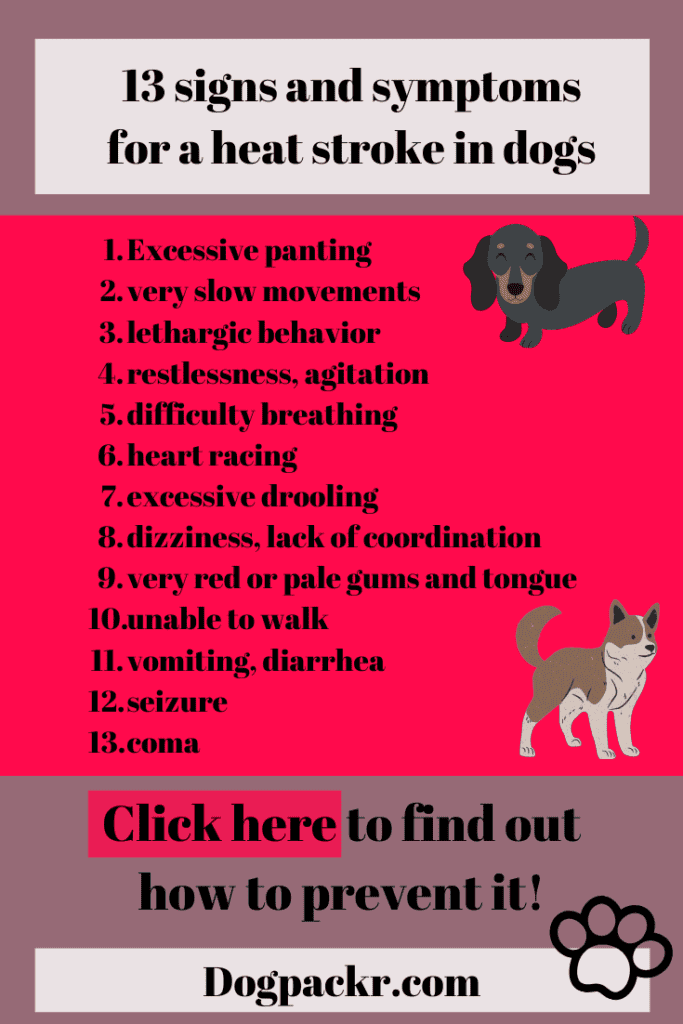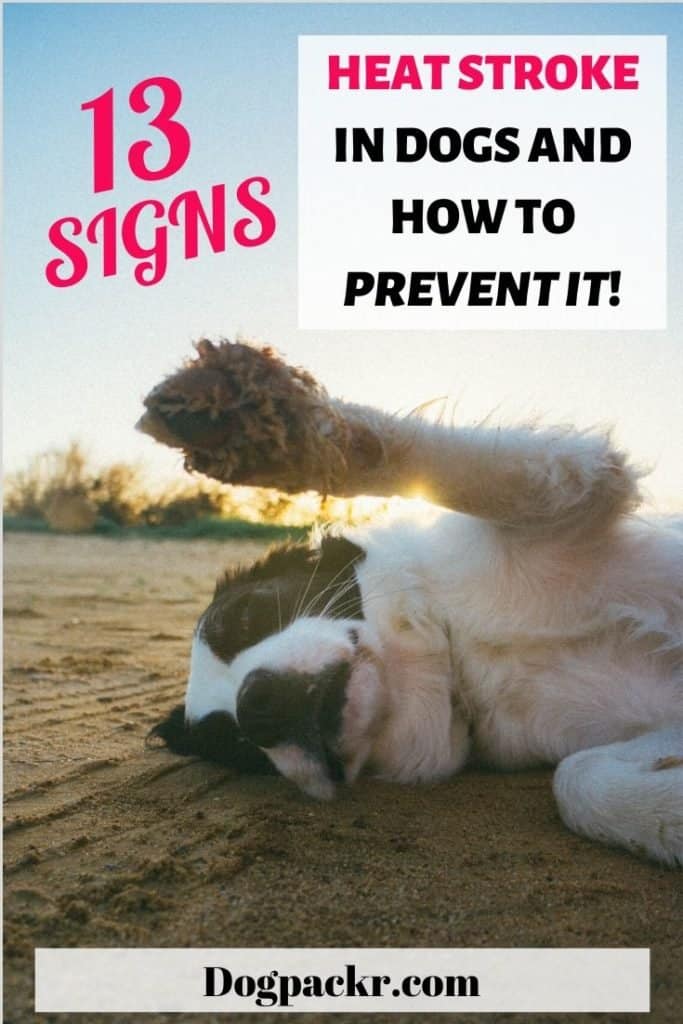
With the temperatures rising I want to talk about a very important question: what are the signs and symptoms for a heat stroke in dogs?
A heat stroke is a very severe condition that can not only lead to permanent mental or physical damage but can also kill your dog!
This is why it’s very important to know the signs and symptoms for heat strokes in dogs so that you can react in time. But even more important is to know how to prevent it. Because prevention is always the better solution!
In this article you’ll learn how to discover a heat stroke in dogs, how to treat it and how to prevent it.
Table of Contents
What causes a heat stroke in dogs?
Let’s start with some important questions, so that you can fully understand heat strokes in dogs.
A heat stroke is caused by the dog being exposed to too much heat. This result is the dog being unable to cool himself enough by panting.
Not all dogs are equally prone to heat strokes. Overweight and older dogs, as well as brachycephalic dog breeds, breeds with very thick coats and very large breeds are generally at higher risk to suffer from heat strokes.
How long does a heat stroke last in dogs?
This totally depends on the severity of the heat stroke your dog is suffering from. If he’s exposed to extreme heat without warning (like a closed car in the sun), he’ll be dead in minutes!
If it’s less severe the symptoms can be gone after a few hours. However, your dog might still feel the effects for 48 to 72 hours if he suffered from organ damage.
What’s the difference between heat exhaustion and a heat stroke in dogs?
Heat exhaustion is basically one step before a heat stroke. It just means that your dog is very hot and is barely capable of regulating his body temperature. As soon as he can’t regulate his body temperature anymore, he suffers from a heat stroke.
For more information on heat exhaustion in dogs, check out my article about the 18 exhausted dog symptoms.

When can the heat exhaustion become a heat stroke?
Dogs can only regulate their body temperature through panting. If this isn’t enough to cool him down, a dog’s body temperature rises. He can actually get a fever from being too hot, which is also referred to as hyperthermia or heat stroke.
Here’s a good explanation from VCAHospitals: “Generally speaking, if a pet’s body temperature exceeds 103°F (39.4°C), it is considered abnormal or hyperthermic. Body temperatures above 106°F (41°C) without previous signs of illness are most commonly associated with exposure to excessive external or environmental heat and are often referred to as heat stroke. The critical temperature where multiple organ failure and impending death occurs is around 107°F to 109°F (41.2°C to 42.7°C).”
Can a dog survive a heat stroke?
Yes, dogs can survive heat strokes. But only if they get help very fast! It also depends how severe the heat stroke is. As soon as he’s suffering from multiple organ failure, he’s very close to death.
This is why I can’t stress enough that you know the signs and symptoms and can react as quickly as possible. So, let’s get to it!
13 signs and symptoms for a heat stroke in dogs
The first stage to a heat stroke is heat exhaustion, so the first few symptoms are actually the same. If he also shows the sings from nr. 9 on, then he’s definitely suffering from a heat stroke.
1. Excessive panting
This is the first, very clear sign. If your dog’s tongue is hanging on the ground and he’s panting like crazy, you should definitely get him some water and put him in the shade.
2. Very slow movements
You’ve probably already seen your dog moving much slower when it’s hot, right? Well, you always have to keep in mind that he’s wearing the almost same coat in winter and in summer. That just makes him hot! But once he’s moving extremely slowly, he’s overheating.
3. Lethargic behavior
Does your dog not respond to your commands or even his name anymore? Does he reject his favorite treats? Another sign, that he’s had too much heat.
4. Restlessness, agitation
On the other hand, it’s also possible that your dog is very agitated and restless because he’s becoming desperate.
5. Difficulty breathing
If the air is very hot, dogs can’t pant enough to regulate their body temperature. This can lead to very heavy and fast breathing because they just can’t get enough cooling air inside.
6. Heart racing
Another sign for heat exhaustion and heat stroke is a racing heart. Feel his chest, is his heart going super fast? Okay, time for some rest in the shade. This will definitely come with excessive panting.

7. Excessive drooling
If it’s hot and your dog is drooling excessively without any food in front of his nose, then this is another symptom for heat exhaustion.
8. Dizziness, lack of coordination
Can your dog still walk but seems a bit off? Is he unable to walk straight? Another clear sign that he needs some shade and water.
9. Very red or pale gums and tongue
With rising body temperature your dog’s gum and tongue can become dark red or blue. If he’s suffering from oxygen depletion, his gums can also turn pale.
10. Unable to walk
The next step would be that he’s not even able to walk anymore. If it’s hot and humid, it’s high time to let him cool down. If he can’t get up even after being in a cooler place for about 30 minutes, you should call your vet!
11. Vomiting, diarrhea
If your dog is also vomiting or has diarrhea, it’s time to call your vet! If there’s also blood in it it’s very likely that he’s bleeding on the inside.
12. Seizure
If your dog is suffering from a seizure after being exposed to hot temperatures, you immediately have to rush to the vet! This means that the oxygen supply to the brain has been disrupted. So, there’s no time to lose!
Here’s an explanatory video on seizures:
13. Coma
The same goes for coma. If your dog is unconscious it’s very likely that he’s already suffering from internal bleeding which can be a result from the heat stroke.
Here’s a good video from Dr. Alex, summarizing the signs of heat strokes in dogs:
How to prevent a heat stroke in dogs
The best way to treat heat strokes in dogs is clearly prevention! There’s absolutely no need for your dog to ever suffer from a heat stroke. And it’s actually pretty easy!
Never leave your dog in a locked car!
By far the most important thing is to never ever leave your dog in the car when the sun is out!!!
There literally isn’t any good excuse to do it! Even if you think it will only be 5 minutes. What if you meet a friend on the way, start talking and forget that you should get back to your car immediately? What if you have an accident in the store? Or what if there’s an emergency and you have to help someone?
While these scenarios might seem unlikely, they are possible. And this can be deadly for your dog!
Never leave your dog in the sun without shade or water
The second thing to do to prevent heat exhaustion in dogs is to never leave him in the sun without shade and water for an extended period.
On really hot days (over 95°F / 35°C), only let your dog outside in the cooler mornings and evenings. And when the sun is shining but it’s not super hot, then make sure he’s always got a shady spot to lie in and lots of water.
Don’t shower him before a walk in the heat
The intent might be good if you’re showering your dog before you take him on a walk in the heat. However, a dog’s fur also protects him from the sun. Not very much, but at least the heat can’t get onto his skin immediately.
If you’re putting water on him and then go into the sun, this protection is gone, which actually puts him at greater risk to suffer from a heat stroke.
Avoid the hottest part of the day
If you’re living in a place where it can get really hot in summer, don’t take your dog on a walk during lunchtime. This is just too hot and even being out for 15 or 20 minutes can be fatal!
Instead, only do a quick potty break and play some games inside. Here are 21 ideas of fun things to do with your dog at home.
Use the cooler mornings and evenings to take your pup for walks.
Use cooling coats and cooling mats
If you know that your dog quickly suffers from warm temperatures and you have to go out with him, there are great tools to help your dog.
Cooling vests are great to help your pup stay cool on walks. However, this doesn’t mean you shouldn’t take all the other prevention measures. It’s just a little helper.
Cooling mats are also a great way to help your pup stay cool, whether you’re in the house or outside.

How to treat a heat stroke in dogs
Prevention is great. But what if it still happened and your dog is showing multiples signs and symptoms of a heat stroke?
In that case, take the following measures.
Get him to a cooler place
First of all, get him out of the heat!
Get him into the shade or your house if this is cooler than outside.
Call your vet
If you think your dog suffers from a heat stroke and shows severe signs, call your vet while doing the next steps on the list. She can assist you by telling you exactly what to do.
Btw, vet costs can become expensive quite quickly. This is why I recommend you either self-insure or you get a pet insurance. Check out my article on the question “is it worth getting pet insurance for dogs” to find out more.
The following things are helpful in any case, though.
Give him water (room temperature) or wet his tongue
If your dog is still conscious he might still be able to drink. Give him a little at first and then let him drink as much as he wants.
If he can’t drink anymore, wet his tongue and gums with a few drops or a wet cloth.
Give him a shower or let him take a bath
If there’s a body of water like a stream, a pool or a tub and your dog can still walk, let him go inside, if he wants.
Otherwise give him a shower with cold water (not icy). If he doesn’t want that, make sure to at least wet his paws, neck and back.
Measure his temperature
A dog’s normal temperature is between 100 to 102.5°F (38 to 39.2°C). Anything higher than that is a sure sign that your dog suffers from a heat stroke.
It’s important to know your dog’s temperature so that you can tell how bad the stroke is. But it’s also important to observe how it goes down. Once his temperature is at 102°F, stop the cooling measure. Otherwise it might lead to a shock.

Cool him down slowly
If you take your dog inside, make sure it’s not cooled down to 65°F (18°C) if it’s 104°F (40°C) outside. This again could lead to a shock.
An overheated dog has to be able to let his body accustom slowly. For that reason you should also make sure that the water you’re cooling him off with isn’t ice cold. Water will cool him down even if it’s warm. Room temperature is best, though.
Don’t use ice!
Under no circumstances use ice! This is way too cold for an overheated dog. Just use water at room temperature and possibly a cooling mat and a wet towel to cool him down.
Stop cooling when his temperature is at 102° F
Continue to measure his temperature. Stop the cooling process when his temperature is around 102°F, as this is his normal body temperature. Again, you don’t want to overcool him as his weakened body can’t deal with that!
Get him to the vet ASAP
After you made sure that your dog doesn’t get worse you should get him to a vet ASAP. If his temperature has risen and if he couln’t get up at a point, you should definitely take him to a vet, even if he responded well to the measures taken.
Dogs suffering from a heat stroke can start to bleed internally which can be fatal if not looked after.
So, always to visit a vet if you think you’re dog is suffering from a heat stroke!
Conclusion
Alright, now you’re prepared for hot summer days with your pooch.
You know how to prevent a heat stroke, the sings and symptoms of a heat stroke in dogs if it occurs after all. And you also know exactly what to do when it happens.
*Disclosure: This post may contain affiliate links, meaning, I get a commission if you decide to make a purchase through one of my links, at no cost to you.


